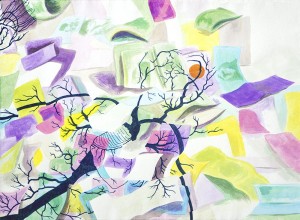In 2018, I created a body of work called Survival Tools consisting of large-scale woodcuts. Survival Tools tells the story of a gundog and bulldog (with a bullhorn head). The gundog represents war and violence, the bulldog protest and speech. At the center of their conflict is a desire to fight for what each believes in necessary to survive. The story ruminates on how difficult it can be to reconcile disagreement, not because individuals are far apart, but because they are intimately close. It’s the jarring feeling of when we cannot come to terms with neighbors and family members despite our proximity. Each cut and line is an indelible record of what we choose to memorialize and struggle to rectify.

Where these struggles occur is what I have come to call the Uncommon Ground. From personal to professional to political spaces, I have paid attention to disputes between people who plead for common ground yet gloss over perspectives and leave issues unresolved. I have wondered that if instead of common ground, we should advocate and claim space for identities and representations that are rare.
Uncommon Ground creates space for different symbols to take shape and establish new understandings. For example, the gundog and bulldog reveal what it takes to be “man’s best friend.” This is an animal that once intended to live symbiotically with “man,” whose breeding and socializing have been manipulated for service, obedience, and pedigree. The Globe Weaver Spider creates infrastructure for illuminated worlds. She is a symbol of female power that people, especially young girls, are taught to fear and hate. Here, the Globe Weaver has space to be undeniably beautiful as she spins her own tale. Finally, the tree-headed person asserts her identity in environments distant from her heritage, yet rooted in her ability to challenge old assumptions in favor of new revelations.

Uncommon Ground evaluates what has been lost amidst cultural struggles and assimilations. It flips the perspective on familiar but ill-told stories. It challenges the archetypes that have shaped how people traditionally understand a story, and what they celebrate or reject. In this rare but expanding space, spiders build matriarchies here. Women reclaim the allegories that misrepresented them.

As a first generation American and woman of color who grew up in the rural Midwest; as the daughter of working class immigrants who lived through famine, revolution, and cultural assimilation; as a former public school educator during Act 10; as a Millennial who worked in the manufacturing industry post 2008 recession; and now as a full-time artist and entrepreneur in the US where there is minimal infrastructure for the arts industry and less than 1% representation of diverse women artists, these stories and symbols come from a place of hope and persistence, of ownership after loss. There are others like us, equally uncommon, who gain permission to claim space from the stories that each of us shares and is willing to own. This is space to unlearn outdated beliefs, to nurture that which is rare within us and nonexistent without us.

Exhibition statement for Uncommon Ground, new work debuting at Diane Endres Ballweg Gallery, third level gallery at Madison Public Library, 201 W Mifflin St. Opening Reception on Friday, August 2, 2019, from 6 to 9 pm. On view through September 27th.





